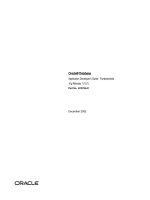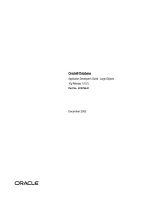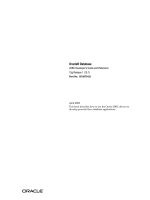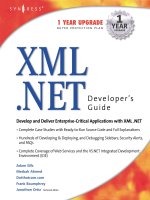ODP .NET Developer''''s Guide oracle database 10g development with visual studio 2005 phần 5 pdf
Bạn đang xem bản rút gọn của tài liệu. Xem và tải ngay bản đầy đủ của tài liệu tại đây (648.12 KB, 33 trang )
Programming ODP.NET with PL/SQL
[ 116 ]
As the routine getSalaryGrade accepts one parameter and returns one value, the
following statements add two parameters (one for the input parameter and the other
for the return value) to OracleCommand:
.Parameters.Add("v_grade", OracleDbType.Int16,
Nothing, Nothing, ParameterDirection.ReturnValue)
.Parameters.Add("v_empno", OracleDbType.Decimal,
Nothing, 7839, ParameterDirection.Input)
Once the OracleCommand is executed, the value is retrieved using the following
statement:
Dim Result As String = _
.Parameters("v_grade").Value.ToString
Finally, the output is displayed using the following statement:
MessageBox.Show("Succesfully executed with result: "
& Result)
Passing Arrays to and Receiving Arrays from
Oracle Database
There are several methods to send information to Oracle database. We can send
information using parameters, XML, Associative Arrays, Ref Cursors, etc. If you
would like to send a single value to Oracle database, it is very easy by using
parameters. If you would like to send several (an unknown number of) values to
Oracle, the issue becomes a bit complicated. We may have to use PL/SQL packages
along with certain Oracle constructs to handle our application requirements.
In this section, we will cover using associative arrays in ODP.NET to send arrays of
information to and receive arrays from Oracle database.
Sending an Array to Oracle Database
The following package demonstrates the use of the PL/SQL table type to receive an
array from an application outside the Oracle database:
CREATE OR REPLACE PACKAGE pck_emp_tabledemo IS
TYPE t_num_array IS TABLE OF NUMBER INDEX BY
BINARY_INTEGER;
PROCEDURE IncreaseSalaries(v_EmpArray t_num_array,
v_IncSal number);
END pck_emp_tabledemo;
/
Chapter 5
[ 117 ]
CREATE OR REPLACE PACKAGE BODY pck_emp_tabledemo IS
PROCEDURE IncreaseSalaries(v_EmpArray t_num_array,
v_IncSal number) IS
BEGIN
FOR i IN 1 v_EmpArray.LAST
LOOP
UPDATE emp SET sal = sal + v_IncSal
WHERE empno = v_EmpArray(i);
END LOOP;
END;
END pck_emp_tabledemo;
/
In this package, you can observe that a PL/SQL table type is declared as follows:
TYPE t_num_array IS TABLE OF NUMBER INDEX BY
BINARY_INTEGER;
It is simply a user-dened data type that can hold a set of numbers. The routine
available as part of the package accepts a parameter, which is of the same data type,
as follows:
PROCEDURE IncreaseSalaries(v_EmpArray t_num_array,
v_IncSal number);
The following code sends an array of values to the procedure available in the
PL/SQL package:
Private Sub btnPassArrayToSP_Click(ByVal sender As
System.Object, ByVal e As System.EventArgs) Handles
btnPassArrayToSP.Click
'create connection to db
Dim cn As New OracleConnection("Data Source=xe; _
User Id=scott;Password=tiger")
Try
'create command object
Dim cmd As New OracleCommand
With cmd
'specify that you are working with stored
'procedure
.CommandType = CommandType.StoredProcedure
'provide the name of stored procedure
.CommandText =
"pck_emp_tabledemo.IncreaseSalaries"
'provide parameter details
Programming ODP.NET with PL/SQL
[ 118 ]
Dim p_empno As OracleParameter =
.Parameters.Add("v_EmpArray",
OracleDbType.Int32, ParameterDirection.Input)
p_empno.CollectionType =
OracleCollectionType.PLSQLAssociativeArray
p_empno.Value = New Int32() {7788, 7876, 7934}
.Parameters.Add("v_IncSal", OracleDbType.Decimal,
Nothing, 500, ParameterDirection.Input)
'proceed with execution
.Connection = cn
.Connection.Open()
.ExecuteNonQuery()
.Connection.Close()
.Dispose()
MessageBox.Show("Succesfully executed")
End With
Catch ex As Exception
'display if any error occurs
MessageBox.Show("Error: " & ex.Message)
'close the connection if it is still open
If cn.State = ConnectionState.Open Then
cn.Close()
End If
End Try
End Sub
Let us go step by step as follows:
Dim p_empno As OracleParameter = _
.Parameters.Add("v_EmpArray", OracleDbType.Int32,
ParameterDirection.Input)
The above denes a new OracleParameter named v_EmpArray.
p_empno.CollectionType =
OracleCollectionType.PLSQLAssociativeArray
The parameter p_empno is specied as a CollectionType and that too of the type
PLSQLAssociativeArray. When the OracleParameter is dened with this type,
then it is capable of holding multiple values.
p_empno.Value = New Int32() {7788, 7876, 7934}
As p_empno can hold multiple values, the above statement assigns a set of values in
the form of an array.
Chapter 5
[ 119 ]
Receiving an Array from Oracle Database
The following package demonstrates the use of the PL/SQL table type to send an
array of values from Oracle database to external applications:
CREATE OR REPLACE PACKAGE pck_emp_tabledemo IS
TYPE t_num_array IS TABLE OF NUMBER INDEX BY
BINARY_INTEGER;
PROCEDURE GetEmployeesOfDept(v_Deptno NUMBER,
v_EmpArray OUT t_num_array);
END pck_emp_tabledemo;
/
CREATE OR REPLACE PACKAGE BODY pck_emp_tabledemo IS
PROCEDURE GetEmployeesOfDept(v_Deptno NUMBER,
v_EmpArray OUT t_num_array) IS
i NUMBER(3) := 1;
BEGIN
FOR e IN (SELECT empno FROM emp WHERE
deptno = v_Deptno)
LOOP
v_EmpArray(i) := e.empno;
i := i + 1;
END LOOP;
END;
END pck_emp_tabledemo;
The above highlighted code is where we dene output parameters to send
the arrays back to the application. If you are familiar with BULK COLLECT, you
can rewrite the package body as follows (just to minimize code and make it
very efcient):
CREATE OR REPLACE PACKAGE BODY pck_emp_tabledemo IS
PROCEDURE GetEmployeesOfDept(v_Deptno NUMBER,
v_EmpArray OUT t_num_array) IS
BEGIN
SELECT empno BULK COLLECT INTO v_EmpArray
FROM emp WHERE deptno = v_Deptno;
END;
END pck_emp_tabledemo;
/
The following code receives an array of values from the procedure available in the
PL/SQL package:
Private Sub btnReceiveAryFromSP_Click(ByVal sender As
System.Object, ByVal e As System.EventArgs) Handles
btnReceiveAryFromSP.Click
'create connection to db
Programming ODP.NET with PL/SQL
[ 120 ]
Dim cn As New OracleConnection("Data Source=xe; _
User Id=scott;Password=tiger")
Try
'create command object
Dim cmd As New OracleCommand
With cmd
'specify that you are working with
'stored procedure
.CommandType = CommandType.StoredProcedure
'provide the name of stored procedure
.CommandText =
"pck_emp_tabledemo.GetEmployeesOfDept"
'provide parameter details
.Parameters.Add("v_Deptno", OracleDbType.Int32,
10, ParameterDirection.Input)
Dim p_empno As OracleParameter = _
.Parameters.Add("v_EmpArray",
OracleDbType.Int32, ParameterDirection.Output)
p_empno.CollectionType = _
OracleCollectionType.PLSQLAssociativeArray
p_empno.Size = 10
'proceed with execution
.Connection = cn
.Connection.Open()
.ExecuteNonQuery()
'get the result out
Dim Empno() As _
Oracle.DataAccess.Types.OracleDecimal =
p_empno.Value
.Connection.Close()
.Dispose()
Dim strEmpno As String = String.Empty
For Each en As
Oracle.DataAccess.Types.OracleDecimal In Empno
strEmpno &= en.ToString & ","
Next
MessageBox.Show("Succesfully executed with
result: " & strEmpno)
End With
Catch ex As Exception
'display if any error occurs
MessageBox.Show("Error: " & ex.Message)
Chapter 5
[ 121 ]
'close the connection if it is still open
If cn.State = ConnectionState.Open Then
cn.Close()
End If
End Try
End Sub
Let us go step by step:
Dim p_empno As OracleParameter = _
.Parameters.Add("v_EmpArray", OracleDbType.Int32,
ParameterDirection.Output)
p_empno.CollectionType =
OracleCollectionType.PLSQLAssociativeArray
p_empno.Size = 10
The above denes an OracleParameter named p_empno as PLSQLAssociativeArray.
You must note that it is dened as an Output parameter. We are also required to
specify the number of values (Size) expected in that parameter.
Once the OracleCommand gets executed, we retrieve the whole set of values into an
array as follows:
Dim Empno() As Oracle.DataAccess.Types.OracleDecimal = _
p_empno.Value
Finally, we concatenate all those values to form a single string value and display the
string back to the user using the following statements:
For Each en As Oracle.DataAccess.Types.OracleDecimal
In EmpnoIn Empno
strEmpno &= en.ToString & ","
Next
MessageBox.Show("Succesfully executed with result: "
& strEmpno)
Another important point to note is that the number of values you are about to receive
must be already known to you for specifying the Size. If the value is higher than
the number of values being received from database, it doesn't really give us any
problem. But, if the value is lower, it certainly raises an error.
You can observe that specifying Size in advance is bit problematic and really not
practical in every scenario. In such situations, you are encouraged to opt for the
usage of REF CURSOR.
Programming ODP.NET with PL/SQL
[ 122 ]
Working with REF CURSOR Using ODP.NET
A REF CURSOR is simply a pointer or reference to the result set available at the server.
Before we can use REF CURSOR, it is required to open it using a SELECT statement. REF
CURSOR is very helpful to .NET to retrieve server-side result sets efciently. Unlike
associative arrays with PL/SQL tables, we need not specify the number of values or
rows being returned.
Pulling from REF CURSOR Using OracleDataReader
Let us start with creating a REF CURSOR within a PL/SQL package and then try
to access it using a .NET application. Following is the sample PL/SQL package
developed for this demonstration:
CREATE OR REPLACE PACKAGE pck_emp_Curdemo IS
TYPE t_cursor IS REF CURSOR;
PROCEDURE GetList(cur_emp OUT t_cursor);
END pck_emp_Curdemo;
/
CREATE OR REPLACE PACKAGE BODY pck_emp_Curdemo IS
PROCEDURE GetList(cur_emp OUT t_cursor) IS
BEGIN
OPEN cur_emp FOR
SELECT empno,ename,sal,deptno
FROM emp;
END;
END pck_emp_Curdemo;
/
In the above package, a separate user-dened datatype t_cursor (which is of type
REF CURSOR) is declared as follows:
TYPE t_cursor IS REF CURSOR;
If you don't want to declare a special type for REF CURSOR, you can modify the above
code as follows, which deals with SYS_REFCURSOR:
CREATE OR REPLACE PACKAGE pck_emp_Curdemo IS
PROCEDURE GetList(cur_emp OUT SYS_REFCURSOR);
END pck_emp_Curdemo;
/
CREATE OR REPLACE PACKAGE BODY pck_emp_Curdemo IS
PROCEDURE GetList(cur_emp OUT SYS_REFCURSOR) IS
BEGIN
OPEN cur_emp FOR
Chapter 5
[ 123 ]
SELECT empno,ename,sal,deptno
FROM emp;
END;
END pck_emp_Curdemo;
/
In any case, the procedure GetList simply returns the output of a SELECT statement
executed by the OPEN statement of PL/SQL to the calling application using the
output parameter cur_emp.
The following code displays all employees by pulling data from REF CURSOR using
OracleDataReader:
Private Sub btnGetEmployees_Click(ByVal sender As
System.Object, ByVal e As System.EventArgs) Handles
btnGetEmployees.Click
'create connection to db
Dim cn As New OracleConnection("Data Source=xe; _
User Id=scott;Password=tiger")
Try
'create command object
Dim cmd As New OracleCommand
With cmd
'specify that you are working with
'stored procedure
.CommandType = CommandType.StoredProcedure
'provide the name of stored procedure
.CommandText = "pck_emp_Curdemo.GetList"
'provide parameter details
.Parameters.Add("cur_emp",
OracleDbType.RefCursor,
ParameterDirection.Output)
'proceed with execution
.Connection = cn
.Connection.Open()
'get the DataReader object from command object
Dim rdr As OracleDataReader =
cmd.ExecuteReader(CommandBehavior.CloseConnection)
'check if it has any rows
If rdr.HasRows Then
With Me.DataGridView1
'remove existing rows from grid
.Rows.Clear()
'get the number of columns
Dim ColumnCount As Integer = rdr.FieldCount
'add grid header row
For i As Integer = 0 To ColumnCount - 1
Programming ODP.NET with PL/SQL
[ 124 ]
.Columns.Add(rdr.GetName(i),
rdr.GetName(i))
Next
.AutoSizeColumnsMode =
DataGridViewAutoSizeColumnsMode.ColumnHeader
'loop through every row
While rdr.Read
'get all row values into an array
Dim objCells(ColumnCount - 1) As Object
rdr.GetValues(objCells)
'add array as a row to grid
.Rows.Add(objCells)
End While
End With
Else
'display message if no rows found
MessageBox.Show("Not found")
Me.DataGridView1.Rows.Clear()
End If
'clear up the resources
rdr.Close()
.Connection.Close()
.Dispose()
MessageBox.Show("Succesfully executed")
End With
Catch ex As Exception
'display if any error occurs
MessageBox.Show("Error: " & ex.Message)
'close the connection if it is still open
If cn.State = ConnectionState.Open Then
cn.Close()
End If
End Try
End Sub
The only new statement from this code is the OracleParameter dened with the
type OracleDbType.RefCursor (which is also dened as an Output parameter)
as follows:
.Parameters.Add("cur_emp", OracleDbType.RefCursor,
ParameterDirection.Output)
This denition, at run time, would automatically hook up with the REF CURSOR being
returned from the procedure GetList available as part of the PL/SQL Package. To
receive information from the REF CURSOR, we used an OracleDataReader as follows:
Dim rdr As OracleDataReader = _
cmd.ExecuteReader(CommandBehavior.CloseConnection)
Chapter 5
[ 125 ]
Once the reader is ready, we lled up the grid with rows and columns.
Filling a Dataset from REF CURSOR
In the previous section, we used OracleDataReader to pull the information from
REF CURSOR. In this section, we will use OracleDataAdapter to do the same and
ll a DataSet. We will be still using the same PL/SQL package listed in the
previous section.
The following code makes use of OracleDataAdapter to ll a DataSet by pulling
the information out of REF CURSOR:
Private Sub btnGetEmployeesDS_Click(ByVal sender As
System.Object, ByVal e As System.EventArgs) Handles
btnGetEmployeesDS.Click
Me.DataGridView1.Rows.Clear()
'create connection to db
Dim cn As New OracleConnection("Data Source=xe; _
User Id=scott;Password=tiger")
Try
'create command object
Dim cmd As New OracleCommand
With cmd
'specify that you are working with
'stored procedure
.CommandType = CommandType.StoredProcedure
'provide the name of stored procedure
.CommandText = "pck_emp_Curdemo.GetList"
'provide parameter details
.Parameters.Add("cur_emp",
OracleDbType.RefCursor,
ParameterDirection.Output)
'proceed with execution
.Connection = cn
End With
Dim ds As New DataSet
Dim da As New OracleDataAdapter(cmd)
da.Fill(ds, "emp")
da.Dispose()
Me.DataGridView1.DataSource = ds.Tables("emp")
MessageBox.Show("Succesfully executed")
Catch ex As Exception
'display if any error occurs
MessageBox.Show("Error: " & ex.Message)
'close the connection if it is still open
If cn.State = ConnectionState.Open Then
Programming ODP.NET with PL/SQL
[ 126 ]
cn.Close()
End If
End Try
End Sub
Even in this program, there is nothing new again except that OracleParameter is
dened of type OracleDbType.RefCursor as follows:
.CommandType = CommandType.StoredProcedure
.CommandText = "pck_emp_Curdemo.GetList"
.Parameters.Add("cur_emp", OracleDbType.RefCursor, ParameterDirection.
Output)
Once the parameters are set, the dataset is lled using the following set of statements:
Dim ds As New DataSet
Dim da As New OracleDataAdapter(cmd)
da.Fill(ds, "emp")
da.Dispose()
Finally, we display the information back to the user by showing the grid as follows:
Me.DataGridView1.DataSource = ds.Tables("emp")
MessageBox.Show("Succesfully executed")
Working with Multiple Active Result Sets (MARS)
Now that we have seen REF CURSOR and how to access it from .NET, it is time to
work with multiple Ref Cursors simultaneously. A routine in a PL/SQL package
can even return more than one REF CURSOR. Following is a sample PL/SQL package,
which does this:
CREATE OR REPLACE PACKAGE pck_emp IS
PROCEDURE get_all(p_emp OUT SYS_REFCURSOR,
p_dept OUT SYS_REFCURSOR);
END pck_emp;
/
CREATE OR REPLACE PACKAGE BODY pck_emp IS
PROCEDURE get_all(p_emp OUT SYS_REFCURSOR,
p_dept OUT SYS_REFCURSOR) IS
BEGIN
OPEN p_emp FOR SELECT empno,ename,sal,deptno FROM emp;
OPEN p_dept FOR SELECT deptno,dname,loc FROM dept;
END;
END pck_emp;
/
Chapter 5
[ 127 ]
From this PL/SQL package, you can observe that the get_all routine is returning
two Ref Cursors back to the calling program or our .NET application. It is declared as
follows:
PROCEDURE get_all(p_emp OUT SYS_REFCURSOR,
p_dept OUT SYS_REFCURSOR);
As two Ref Cursors are used, we need to work with two OPEN statements as follows:
OPEN p_emp FOR SELECT empno,ename,sal,deptno FROM emp;
OPEN p_dept FOR SELECT deptno,dname,loc FROM dept;
The following code reads both of those Ref Cursors using OracleDataReader and
displays the result in two different grids:
Private Sub btnGetDataset_Click(ByVal sender As
System.Object, ByVal e As System.EventArgs) Handles
btnGetDataset.Click
Me.DataGridView1.Rows.Clear()
Me.DataGridView2.Rows.Clear()
'create connection to db
Dim cn As New OracleConnection("Data Source=xe; _
User Id=scott;Password=tiger")
Try
'create command object
Dim cmd As New OracleCommand
With cmd
'specify that you are working with stored
'procedure
.CommandType = CommandType.StoredProcedure
'provide the name of stored procedure
.CommandText = "pck_emp.Get_All"
'provide parameter details
.Parameters.Add("p_emp", OracleDbType.RefCursor,
ParameterDirection.Output)
.Parameters.Add("p_dept",OracleDbType.RefCursor,
ParameterDirection.Output)
'proceed with execution
.Connection = cn
.Connection.Open()
'execute the query
.ExecuteNonQuery()
'get the DataReader objects from
'parameter objects
Dim rdr_emp As OracleDataReader = _
CType(.Parameters("p_emp").Value,
Oracle.DataAccess.Types.OracleRefCursor)
.GetDataReader
Programming ODP.NET with PL/SQL
[ 128 ]
Dim rdr_dept As OracleDataReader = _
CType(.Parameters("p_dept").Value,
Oracle.DataAccess.Types.OracleRefCursor)
.GetDataReader
'check if rdr_emp has any rows
If rdr_emp.HasRows Then
With Me.DataGridView1
'remove existing rows from grid
.Rows.Clear()
'get the number of columns
Dim ColumnCount As Integer = _
rdr_emp.FieldCount
'add grid header row
For i As Integer = 0 To ColumnCount - 1
.Columns.Add(rdr_emp.GetName(i),
rdr_emp.GetName(i))
Next
.AutoSizeColumnsMode =
DataGridViewAutoSizeColumnsMode.ColumnHeader
'loop through every row
While rdr_emp.Read
'get all row values into an array
Dim objCells(ColumnCount - 1) As Object
rdr_emp.GetValues(objCells)
'add array as a row to grid
.Rows.Add(objCells)
End While
End With
End If
'check if rdr_dept has any rows
If rdr_dept.HasRows Then
With Me.DataGridView2
'remove existing rows from grid
.Rows.Clear()
'get the number of columns
Dim ColumnCount As Integer = _
rdr_dept.FieldCount
'add grid header row
For i As Integer = 0 To ColumnCount - 1
.Columns.Add(rdr_dept.GetName(i),
rdr_emp.GetName(i))
Next
.AutoSizeColumnsMode =
DataGridViewAutoSizeColumnsMode.ColumnHeader
'loop through every row
While rdr_dept.Read
Chapter 5
[ 129 ]
'get all row values into an array
Dim objCells(ColumnCount - 1) As Object
rdr_dept.GetValues(objCells)
'add array as a row to grid
.Rows.Add(objCells)
End While
End With
End If
'clear up the resources
rdr_emp.Close()
'clear up the resources
rdr_dept.Close()
.Connection.Close()
.Dispose()
MessageBox.Show("Succesfully executed")
End With
Catch ex As Exception
'display if any error occurs
MessageBox.Show("Error: " & ex.Message)
'close the connection if it is still open
If cn.State = ConnectionState.Open Then
cn.Close()
End If
End Try
End Sub
From the highlighted code, you can observe that two OracleParameter objects
(which are of type REF CURSOR) are dened. They are as follows:
.Parameters.Add("p_emp", OracleDbType.RefCursor,
ParameterDirection.Output)
.Parameters.Add("p_dept", OracleDbType.RefCursor,
ParameterDirection.Output)
After that, we executed the routine in the PL/SQL package with ExecuteNonQuery.
This is very important to note. We are not using ExecuteReader anymore, when
dealing with multiple result sets. Instead, we are using the GetDataReader method
of OracleRefCursor (which creates(which creates OracleDataReader objects) to pull information
from the output parameters. The rst statement that uses it is as follows:
Dim rdr_emp As OracleDataReader = _
CType(.Parameters("p_emp").Value, _
Oracle.DataAccess.Types.OracleRefCursor).GetDataReader
Programming ODP.NET with PL/SQL
[ 130 ]
This returns the result set of of the rst REF CURSOR in the form of an
OracleDataReader. Immediately after that, we used another similar statement to
retrieve the next result set as follows:
Dim rdr_dept As OracleDataReader = _
CType(.Parameters("p_dept").Value, _
Oracle.DataAccess.Types.OracleRefCursor).GetDataReader
Once both the readers were ready, we lled up the grids and nally closed the
readers using the following statements:
rdr_emp.Close()
rdr_dept.Close()
Summary
In this chapter, we mainly concentrated on working with PL/SQL blocks, stored
procedures, PL/SQL packages, PL/SQL tables, and Ref Cursors. While dealing with
stored procedures, we also covered passing and retrieving parameter values with
different types of parameters (IN, OUT, IN OUT). We have also seen techniques for
sending arrays to and receiving arrays from Oracle database using packages and
nally concluded with working on Multiple Active Result Sets (MARS).
Dealing with Large Objects
(LOBs)
Oracle database offers the capability of storing and retrieving images, music, video,
and any other binary information in the form of large objects. The large objects are
typically of type BFILE, BLOB, and CLOB (or NCLOB).
BFILE is generally used when you have les residing in the le system of the Oracle
database server, outside the database. A BFILE value is simply a pointer to an
existing le in the host operating system and does not store the le itself within the
database. However, BLOB (Binary Large Object) gives the capability to store the
binary le or binary information typically of huge size directly within the database
without having any relation with the le system of Oracle server. CLOB (Character
Large Object) is very similar to BLOB, except that it is optimized to store huge text
information efciently. And nally, NCLOB is very similar to CLOB and enhanced
towards storing multi-byte national character set (synonymous with UNICODE).
In simple words, BFILE data is stored externally on the database server and BLOB,
CLOB, and NCLOB data is stored internally within the database. Now, we shall
examine how ODP.NET handles each of these objects.
Working with BFILEs
As explained previously, BFILE-related les are always stored external to the
database. Within the database, we only store the pointers of those les, without
affecting the database size. As the les always stay outside the database, they are
always automatically made read-only for security purposes. Before working with
BFILE type, we need to set up the environment to deal with sample BFILE data.
Dealing with Large Objects (LOBs)
[ 132 ]
Setting Up the Environment to Work with
BFILEs
The rst step to prepare for the sample data is to create a folder named EmpPhotos
on your favorite drive (in my case, it is C:\EmpPhotos). Make sure that you create
that at the Oracle database server (or a drive accessible at the database server) and
not at our application/client system.
Once you have created the folder (which maintains BFILE related les), copy a
few image les manually into that folder (in my case, I copied WinVista.jpg and
Win2003.jpg into that folder).
Now, you need to create a logical directory object within Oracle database, which
points to the folder you created above. You need to have special privileges to create
or administer directory objects in Oracle. If you have access to system user, you can
proceed as follows; else you need to contact your DBA to help you:
sql>CONNECT system/manager;
sql>GRANT CREATE ANY DIRECTORY TO scott;
sql>GRANT DROP ANY DIRECTORY TO scott;
sql>CONNECT scott/tiger;
sql>CREATE OR REPLACE DIRECTORY EMPPHOTOSDIR
AS 'c:\EmpPhotos';
The highlighted code above creates a logical directory object pointing to your
required folder.
Now, create a table that can hold the pointers to the BFILEs as follows:
sql>CREATE TABLE EmpPhotos
(
empno NUMBER(4) PRIMARY KEY,
photo BFILE
);
The above table simply holds employee numbers and pointers to the les existing
at the server.
Chapter 6
[ 133 ]
Following is the sample form designed to work with the BFILE demonstration:
Adding a New Row Containing BFILE
To work with BFILEs, you need not learn anything new. It is just the same INSERT
or UPDATE statement you will use, while inserting or updating rows containing
BFILE information.
Dealing with Large Objects (LOBs)
[ 134 ]
The following code adds an entry into the table created according to our BFILE setup:
Private Sub btnAdd_Click(ByVal sender As System.Object,
ByVal e As System.EventArgs) Handles btnAdd.Click
'create connection to db
Dim cn As New OracleConnection("Data Source=xe; _
User Id=scott;Password=tiger")
Try
'create command object
Dim sb As New System.Text.StringBuilder
sb.Append(" INSERT INTO EmpPhotos")
sb.Append(" (empno, photo)")
sb.Append(" VALUES")
sb.Append(" (" & Me.txtEmpno.Text & ", ")
sb.Append(" BFILENAME('EMPPHOTOSDIR', '" &
Me.txtPhotoPath.Text & "'))")
Dim cmd As New OracleCommand
With cmd
.CommandText = sb.ToString
'proceed with execution
.Connection = cn
.Connection.Open()
.ExecuteNonQuery()
.Connection.Close()
.Dispose()
End With
MessageBox.Show("Succesfully Uploaded")
Catch ex As Exception
'display if any error occurs
MessageBox.Show("Error: " & ex.Message)
'close the connection if it is still open
If cn.State = ConnectionState.Open Then
cn.Close()
End If
End Try
End Sub
From the above highlighted code, you can observe that an Oracle built-in function
BFILENAME is used. It simply accepts the logical Oracle directory name and the le
name; the rest is automatically taken care of by Oracle!
While executing the application, you must only provide the le
name without any path of the le at the database server (it is
identied by the logical directory object).
Chapter 6
[ 135 ]
If everything gets executed ne, you should get output similar to the following:
Updating an Existing BFILE Row
The code for updating an existing BFILE is very similar to that for inserting except
that we need to replace the INSERT statement with an appropriate UPDATE statement.
The following code updates an existing entry in the table containing BFILE
information.
Private Sub btnUpdate_Click(ByVal sender As
System.Object, ByVal e As System.EventArgs) Handles
btnUpdate.Click
'create connection to db
Dim cn As New OracleConnection("Data Source=xe; _
User Id=scott;Password=tiger")
Try
'create command object
Dim sb As New System.Text.StringBuilder
sb.Append(" UPDATE EmpPhotos SET")
sb.Append(" photo=")
sb.Append(" BFILENAME('EMPPHOTOSDIR', '" &
Me.txtPhotoPath.Text & "')")
sb.Append(" WHERE empno=" & Me.txtEmpno.Text)
Dim cmd As New OracleCommand
With cmd
.CommandText = sb.ToString
'proceed with execution
Dealing with Large Objects (LOBs)
[ 136 ]
.Connection = cn
.Connection.Open()
.ExecuteNonQuery()
.Connection.Close()
.Dispose()
End With
MessageBox.Show("Succesfully Uploaded")
Catch ex As Exception
'display if any error occurs
MessageBox.Show("Error: " & ex.Message)
'close the connection if it is still open
If cn.State = ConnectionState.Open Then
cn.Close()
End If
End Try
End Sub
You can observe from the highlighted code that we replaced the entire INSERT
statement with an UPDATE statement.
Retrieving BFILE Information from a Database
Now that we have seen how to update BFILE information to the database, it is
time to retrieve BFILE information from the table. When we try to retrieve BFILE
information from the database, it doesn't retrieve a pointer or link to that le.
Instead, it directly returns you the le (using the BFILE pointer) stored in the le
system of Oracle database server!
The following code retrieves the BFILE information from the database:
Private Sub btnShow_Click(ByVal sender As System.Object,
ByVal e As System.EventArgs) Handles btnShow.Click
'create connection to db
Dim cn As New OracleConnection("Data Source=xe; _
User Id=scott;Password=tiger")
Try
'create command object
Dim sb As New System.Text.StringBuilder
sb.Append(" SELECT photo FROM EmpPhotos")
sb.Append(" WHERE empno = " & Me.txtEmpno.Text)
Dim cmd As New OracleCommand(sb.ToString, cn)
With cmd
.Connection.Open()
Dim rdr As OracleDataReader = .ExecuteReader
If rdr.Read Then
Me.PictureBox1.Image =
Chapter 6
[ 137 ]
Image.FromStream(New IO.MemoryStream
(rdr.GetOracleBFile(rdr.GetOrdinal
("photo")).Value))
End If
.Connection.Close()
.Dispose()
End With
Catch ex As Exception
'display if any error occurs
MessageBox.Show("Error: " & ex.Message)
'close the connection if it is still open
If cn.State = ConnectionState.Open Then
cn.Close()
End If
End Try
End Sub
In the above code, OracleDataReader is used for convenience. You can also use
OracleDataAdapter and populate the same into data tables or data sets. The most
important method is GetOracleBFile. It is the method that returns the BFILE
information back to the application. As we would like to transform that le into an
image, we are temporarily reading the whole BFILE information into a temporary
MemoryStream and later we get it displayed on the form using the static method
Image.FromStream.
You should receive output similar to the following if everything gets successfully
executed:
Dealing with Large Objects (LOBs)
[ 138 ]
Retrieving Properties of a BFILE
You can even retrieve some extra information about a BFILE, when you are using
OracleBFile. You can retrieve and test for certain properties like whether the le
exists at the server, whether it is readable, lename, size, etc.
The following code retrieves the BFILE along with extra information from
the database:
Private Sub btnShowPhoto_Click(ByVal sender As
System.Object, ByVal e As System.EventArgs) Handles
btnShowPhoto.Click
'create connection to db
Dim cn As New OracleConnection("Data Source=xe; _
User Id=scott;Password=tiger")
Try
'create command object
Dim sb As New System.Text.StringBuilder
sb.Append(" SELECT photo FROM EmpPhotos")
sb.Append(" WHERE empno = " & Me.txtEmpno.Text)
Dim cmd As New OracleCommand(sb.ToString, cn)
With cmd
.Connection.Open()
Dim rdr As OracleDataReader = .ExecuteReader
If Not rdr.Read Then
MessageBox.Show("No employee exists")
Else
Dim bfile As _
Oracle.DataAccess.Types.OracleBFile =
rdr.GetOracleBFile(rdr.GetOrdinal("photo"))
If Not bfile.FileExists Then
MessageBox.Show("Photo File does not exist
at server")
Else
If Not bfile.CanRead Then
MessageBox.Show("You do not have
permission to view the photo")
Else
If bfile.IsEmpty Or bfile.IsNull Then
MessageBox.Show("Photo not assigned
to the employee")
Else
Dim dir As String = bfile.DirectoryName
Dim fn As String = bfile.FileName
Chapter 6
[ 139 ]
Dim size As Long = bfile.Length
Me.PictureBox1.Image =
Image.FromStream(New IO.MemoryStream
(bfile.Value))
Dim bfiledetails As New _
System.Text.StringBuilder
bfiledetails.Append("Directory:" & dir
& ControlChars.NewLine)
bfiledetails.Append("File Name:" & fn
& ControlChars.NewLine)
bfiledetails.Append("Size:" & size
& ControlChars.NewLine)
MessageBox.Show(bfiledetails.ToString)
End If 'is null or is empty
End If 'can read
End If 'is file exists
End If 'rdr
.Connection.Close()
rdr.Dispose()
.Dispose()
End With
Catch ex As Exception
'display if any error occurs
MessageBox.Show("Error: " & ex.Message)
'close the connection if it is still open
If cn.State = ConnectionState.Open Then
cn.Close()
End If
End Try
End Sub
The highlighted code shows you how to retrieve several properties of a BFILE object.
The following table summarizes the properties used in this code:
Property Description
FileExists
Indicates whether or not the le exists at the server
CanRead
Indicates whether or not the le can be read
IsEmpty, IsNull Indicates whether the le is empty or not
DirectoryName
Gives the directory (folder) name of the le
FileName
The name of the le
Length
The size of the le in bytes
Dealing with Large Objects (LOBs)
[ 140 ]
Working with CLOBs
CLOB (Character Large Object) gives us the capability to store huge character
information (or huge strings) directly within the database without having any
relation with the le system at Oracle server.
Before trying to design databases with CLOB functionality, you
may have to consider the issues of storage and performance.
Inserting Huge Text Information into Oracle
Database
As CLOBs get stored internally within the Oracle database, we need not create any
directories or work with le systems any more. To demonstrate the functionality of
CLOBs, a table is planned as follows:
CREATE TABLE EmpRemarks
(
empno NUMBER(4) PRIMARY KEY,
remarks CLOB
)
You can observe from the above highlighted line that a column remarks of type CLOB
is created. Here is the code that stores huge text into that CLOB column:. Here is the code that stores huge text into that CLOB column:
Private Sub btnAdd_Click(ByVal sender As System.Object,
ByVal e As System.EventArgs) Handles btnAdd.Click
'create connection to db
Dim cn As New OracleConnection("Data Source=xe; _
User Id=scott;Password=tiger")
Try
'create command object
Dim sb As New System.Text.StringBuilder
sb.Append(" INSERT INTO EmpRemarks")
sb.Append(" (empno, remarks)")
sb.Append(" VALUES")
sb.Append(" (:1,:2)")
Dim cmd As New OracleCommand
With cmd
.CommandText = sb.ToString
'define parameters
Dim p_empno As New OracleParameter(":1", _
OracleDbType.Int16)









